This article needs additional citations for verification .(February 2024) |

The Gourd Dance is a Kiowa dance and song tradition that has become popular at modern powwows in southwestern Oklahoma. [1]
This article needs additional citations for verification .(February 2024) |

The Gourd Dance is a Kiowa dance and song tradition that has become popular at modern powwows in southwestern Oklahoma. [1]
Many Native Americans dispute the origin of the legend of the Gourd Dance. A Kiowa story recounts the tale of a young man who had been separated from the rest of the tribe. Hungry and dehydrated after many days of travel, the young man approached a hill and heard an unusual kind of singing coming from the other side. There he saw a red wolf singing and dancing on its hind legs. The man listened to the songs all afternoon and through the night and when morning came, the wolf spoke to him and told him to take the dance and songs back to the Kiowa people. The "howl" at the end of each gourd dance song is a tribute to the red wolf. The Kiowa Gourd Dance was once part of the Kiowa Sun Dance ceremony.
Beginning in 1890 the United States government began to actively enforce bans on Kiowa cultural ceremonials and the Gourd Dance was out of normal practice by the late 1930s.
In 1957 the Kiowa Director for the American Indian Exposition, Fred Tsoodle, called upon singers Bill Koomsa and William Tanedooah who remembered the Gourd Dance songs. Also called were Clyde Ahtape, Harry Hall Zotigh, Fred Botone, Oliver Tanedooah, and Abel Big Bow in Kiowa Gourd Dance dress to dance to the songs for a special tribal presentation at that year's festivities. Two years later inspired by the presentation several Kiowa men reorganized the Kiowa Gourd Dance Society and formally established the organization on January 30, 1957 and voted on the name "Kiowa Gourd Dance". Within the next decade the organization split into three unrelated branches: the establishing group (now called Kiowa Gourd Clan), Tiah-Piah Society of Oklahoma (established in 1962), and the Tia-piah Society of Carnegie (now known as the Kiowa TiaPiah Society). All three societies hold their annual ceremonials on and around July 4, due to the Gourd Dance at one time being a part of the Sun Dance ceremonials usually held in mid-summer.
The variations on the word "Tia-Piah" used in the names of Kiowa Gourd Dance organizations comes from Jài:fè:gàu (Tdeinpei-gah) [IPA: tãi.peː.gɔ] one of the eight Kiowa warrior societies. Perhaps because of the military connotations of the term the Gourd Dance has often been mistaken for a "veteran's dance". However, leaders of all three of the earliest Kiowa-established gourd dance organizations agree that this is not a requirement to become a member of the societies. Dances from two of the other presently-existing societies, Pòlá:hyòp ("Pah-Lye-Up" or "Rabbit Society") [pʰo.laː.hyop] and Óhòmà:gàu ("Ohomah" or "War Dance Society"), [o.ho.mɔː.gɔ] are incorporated into the Kiowa summer ceremonials before and after the gourd dance sessions.

The Gourd Dance originated with the Kiowa tribe, and is a man's dance. Women participate by dancing in place behind their male counterparts and outside the perimeter formed by the men. The dance in the Kiowa Language is called "Ti-ah pi-ah" which means "ready to go, ready to die".
The Kiowa consider this dance as their dance since it was given to them by "Red Wolf". It has spread to many other tribes and societies, most of which do not have the blessing of the Kiowa Elders. Some gourd societies do not distinguish race as a criterion, and even non-Indians can and are inducted into their gourd societies, the Kiowa gourd dance society however only inducts Indians of half blood or more. Many participants may be older men, and the dance is less energetic and less physically demanding than most pow-wow dances. Some of the Gourd Dances that are held go on all afternoon and on into the evening when it finally cools off enough so that more energetic Intertribal dances can begin. Some Tribal dances feature only Gourd Dancing.
Modern Gourd Dance regalia consists of a red and blue blanket draped over the shoulders. (This accessory represents night and day). Some dancers change the blanket to rest over the heart red during the day and blue after dark. A skunk berry (Ka-hole) and silver beaded bandolier fastened on the left shoulder is draped across the heart. The red skunk berry bandolier was added as a memorial tribute to a battle fought with Cheyenne warriors. The aftermath left the land covered with red blood and is represented by the red skunk berries. A handkerchief bundle of Indian perfume, gathered from the foothills, is tied to the back of the bandolier.
A metal rattle to accompany the drumbeat and a feathered fan usually are held in opposite hands. Normally Kiowa Gourd Clan members do not use real gourds in this dance because they are associated with the Native American Church ceremonies.
Traditionally dressed gourd dancers wear buckskin leggings and a long, red breechcloth. These are covered by a black fringed shawl wrapped above the black shawl to secure it. Today these are accompanied with a long sleeved shirt, bolo tie or tie.
Head attire can include hair wrapped with otter wraps, a roach or otter cap. Following Kiowa protocol, it is considered disrespectful to wear ball caps, T-shirts, cowboy hats or boots while participating in this dance. The four Kiowa headsman of this society urge its members to dress with dignity and discretion.
Like pow-wow dancing, Gourd Dancing is performed in a circular arena. The drum can be placed on the side or in the center of the arena. The dancers take their place around the perimeter of the area. During most of the song, the dancers dance in place, lifting their feet in time to the drumbeats, and shaking their rattles from side to side. At certain points in the singing, the drum beat changes to harder beats. At this point, the dancers will dance in place. When it changes to softer beats the dancers will dance a short distance from their spots.
Typically, the dance begins in the afternoon, and the opening song (referred to as a "Calling Song") is sung first. The head singer will determine how many songs are sung in a set. Usually the slower paced songs are sung in the beginning and progressively faster songs are sung as the gourd dance progresses. When the gourd dance draws to a close, a fast song is usually the last to be performed, but it is not the "official" closing song. Sometimes buffalo songs will be sung after that last gourd dance song.
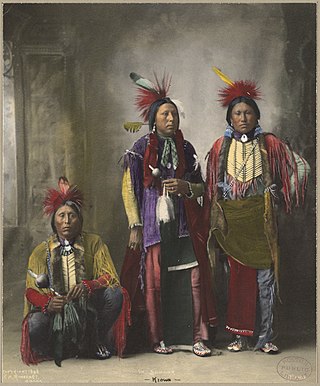
Kiowa or CáuigúIPA:[kɔ́j-gʷú]) people are a Native American tribe and an Indigenous people of the Great Plains of the United States. They migrated southward from western Montana into the Rocky Mountains in Colorado in the 17th and 18th centuries, and eventually into the Southern Plains by the early 19th century. In 1867, the Kiowa were moved to a reservation in southwestern Oklahoma.
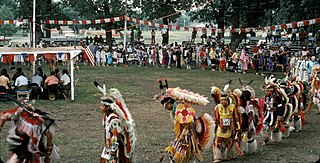
A powwow is a gathering with dances held by many Native American and First Nations communities. Powwows today are an opportunity for Indigenous people to socialize, dance, sing, and honor their cultures. Powwows may be private or public, indoors or outdoors. Dancing events can be competitive with monetary prizes. Powwows vary in length from single-day to weeklong events.

Quanah Parker was a war leader of the Kwahadi ("Antelope") band of the Comanche Nation. He was likely born into the Nokoni ("Wanderers") band of Tabby-nocca and grew up among the Kwahadis, the son of Kwahadi Comanche chief Peta Nocona and Cynthia Ann Parker, an Anglo-American who had been abducted as an eight-year-old child during the Fort Parker massacre in 1836 and assimilated into the Nokoni tribe. Following the apprehension of several Kiowa chiefs in 1871, Quanah Parker emerged as a dominant figure in the Red River War, clashing repeatedly with Colonel Ranald S. Mackenzie. With European-Americans hunting American bison, the Comanches' primary sustenance, into near extinction, Quanah Parker eventually surrendered and peaceably led the Kwahadi to the reservation at Fort Sill, Oklahoma.
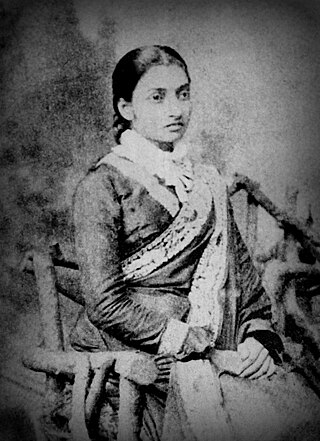
A sari is a women's garment from the Indian subcontinent. It consists of an un-stitched stretch of woven fabric arranged over the body as a robe, with one end attached to the waist, while the other end rests over one shoulder as a stole, sometimes baring a part of the midriff. It may vary from 4.1 to 8.2 metres in length, and 60 to 120 centimetres in breadth, and is a form of ethnic wear in Bangladesh, India, Sri Lanka, Nepal, and Pakistan. There are various names and styles of sari manufacture and draping, the most common being the Nivi style. The sari is worn with a fitted bodice also called a choli and a petticoat called ghagra, parkar, or ul-pavadai. It remains fashionable in the Indian subcontinent today.

Folk music of Haryana has two main forms: classical folk music of Haryana and desi folk music of Haryana. They take the form of ballads and pangs of parting of lovers, valor and bravery, harvest and happiness.
Kiowa music is the music of the Kiowa Tribe of Oklahoma. The Kiowa are a federally recognized tribe, meaning they have a functioning government-to-government relationship with the United States government.

Fancy dance, Pan-Indian dancing, Fancy Feather or Fancy War Dance is a style of dance some believe was originally created by members of the Ponca tribe in the 1920s and 1930s, in an attempt to preserve their culture and religion. It is loosely based on the war dance. Fancy dance was considered appropriate to be performed for visitors to reservations and at "Wild West" shows. But today, fancy dancers can be seen at many powwows across the nation and even the world.

Arunachal Pradesh is a state of India. It is known for dance music, which comes in many different styles. Dances from the region are often ritual in nature, but are also celebratory. They are mostly group dances, though others are restricted to men. Dances include popir, ponung and pasi kongki, rekham pada, aji lhamu and hiirii khaniing.

The stomp dance is performed by various Eastern Woodland tribes and Native American communities in the United States, including the Muscogee, Yuchi, Cherokee, Chickasaw, Choctaw, Delaware, Miami, Caddo, Tuscarora, Ottawa, Quapaw, Peoria, Shawnee, Seminole, Natchez, and Seneca-Cayuga tribes. Stomp dance communities are active in Georgia, North Carolina, Oklahoma, Alabama, Mississippi, and Florida.

Hopi katsina figures, also known as kachina dolls, are figures carved, typically from cottonwood root, by Hopi people to instruct young girls and new brides about katsinas or katsinam, the immortal beings that bring rain, control other aspects of the natural world and society, and act as messengers between humans and the spirit world.

The preservation of fabric fibers and leathers allows for insights into the attire of ancient societies. The clothing used in the ancient world reflects the technologies that these peoples mastered. In many cultures, clothing indicated the social status of various members of society.

The Kaashtha sari is a Koli style of sari draping very similar to the way the Maharashtrian dhoti is worn. The word Kaashtha refers to the sari being tucked at the back. Since this sari is usually worn by using a single nine yard cloth, it is also referred to as Nauvari, which means Nine Yards. Sakachcha sari is another term commonly used to refer to this style of sari. It is referred to as Akanda Vastra, which means it doesn't need any other attire to support it. In fact, this attire holds utmost importance as women across different walks of life have worn it. It is not just worn at religious and cultural events, but women have fought wars in the past and still work in farmlands wearing this.
The Koitsenko was a group of the ten greatest warriors of the Kiowa tribe as a whole, from all bands. One was Satank who died while being taken to trial for the Warren Wagon Train Raid. The Koitsenko were elected out of the various military societies of the Kiowa, the "Dog Soldiers." They were elected by all the members of all the warrior societies of the entire tribe.

The Native American Church (NAC), also known as Peyotism and Peyote Religion, is a syncretic Native American religion that teaches a combination of traditional Native American beliefs and elements of Christianity, especially pertaining to the Ten Commandments, with sacramental use of the entheogen peyote. The religion originated in the Oklahoma Territory (1890–1907) in the late nineteenth century, after peyote was introduced to the southern Great Plains from Mexico. Today, it is the most widespread indigenous religion among Native Americans in the United States, Canada, and Mexico, with an estimated 300,000 adherents.
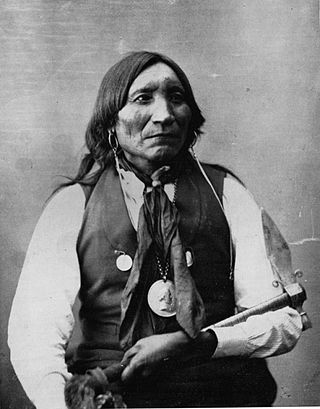
Guipago or Lone Wolf the Elder was the last Principal Chief of the Kiowa tribe. He was a member of the Koitsenko, the Kiowa warrior elite, and was a signer of the Little Arkansas Treaty in 1865.
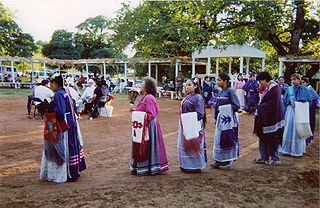
The turkey dance is one of the most important traditional dances among Caddo people. Women dance the turkey dance, while men drum and sing the songs, which describe events in Caddo history.
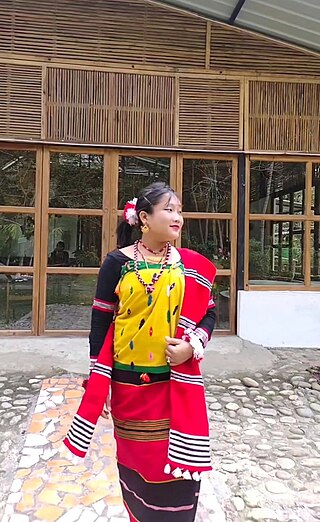
The Mising people are a Sino-Tibetan ethnic group inhabiting mostly in the Northeast Indian states of Assam and Arunachal Pradesh. They are part of the greater Tani group of people of India and Tibet Autonomous Region of China.

Ahpeahtone, also known as Que-Tah-Tsay or Apiatan was a chief of the Kiowa tribe in Oklahoma, who is regarded as the last traditional chief of the tribe.

The Straight Dance, also known as Southern Straight Dance or Southern Traditional, is a style of Native American pow wow dancing. The dance recounts the story of hunting or war parties searching for the enemy.
Khual Lam is a Mizo traditional dance from the Indian state of Mizoram that is performed for guests. Nowadays, it is performed in every major Mizo cultural festival but still maintains the tradition of performing for guests such as the state Chief Minister, or government officials.